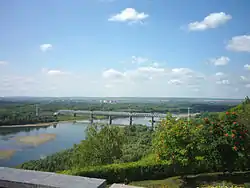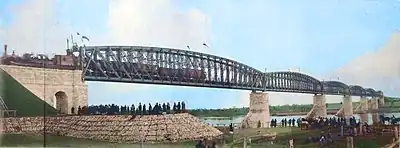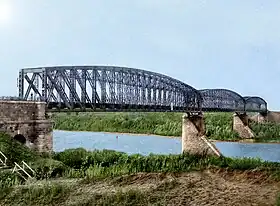Ufa Rail Bridge
Ufa rail bridge carries double tracked rail lines over the River Belaya. It is located at Ufa, the Republic of Bashkortostan, Russia.[1]
Ufa Rail Bridge | |
|---|---|
 | |
| Coordinates | 54.7182°N 55.9079°E |
| Carries | Originally single track it was later widened to double track. |
| Crosses | Belaya river |
| Locale | Ufa, Republic of Bashkortostan, Russia |
| Characteristics | |
| Material | Steel, reinforced concrete, stone |
| Total length | 655.5 m (2,151 ft) |
| No. of spans | 6х109.25 m (358.4 ft) |
| History | |
| Designer | Nikolai Belelubsky |
| Construction start | 1886 |
| Construction end | 1888 |
| Opened | September 8, 1888 |
| Location | |
History
The origins of the bridge are closely associated with that of the Trans-Siberian Railway, for which the structure was built for. Construction of the bridge occurred between 1886 and 1888, having been built at the same time as several other railway bridges on the line, including three-span bridge across the River Ufa, east of Ufa. The construction of both bridges was overseen by civil engineer Professor Nikolai Belelubsky, who followed the specifications outlined in the 1884 edition for steel railway bridges. Due to this adherence to the same design standards, these two bridges shared similar features. Thanks to the successful completion of these bridges, the Trans-Siberian line was able to be extended even further eastward, reaching the towns of Zlatoust in (1890) and Chelyabinsk in (1892).[2][3][4]
For the design of the bridges, Professor Nikolai Belelubsky was called in. Belelubsky's contributions to the field of building materials research were marked by two significant discoveries that had a profound and lasting impact. Firstly, he found that domestically produced cement was just as good as English cement, allowing for a significant cost reduction in bridge construction. Secondly, Belelubsky made groundbreaking progress in understanding the mechanical properties of carbon steel. In 1882, he was the first in Russia to propose the idea of using steel in the construction of railroad bridges. This is because steel for metal bridges had not been yet systematically used in Austria, while in Germany it had been used with caution, in accordance with the technical requirements of the time. Having evaluated the physical and chemical properties of carbon steel, Belelubsky came to the conclusion that, contrary to the opinion of the time, it was a far more reliable material for bridges compared to wrought iron, which was the prevailing choice at the time. His breakthrough allowed him to successfully replace wrought iron with steel in constructing bridges along the four major sections of the Trans-Siberian Railway. The steel specifications developed by Belelubsky served as the foundation for similar specifications that were later adopted internationally.[5]

The bridge superstructure provided originally for six 109-meter (358 ft.) bowstring arch through truss spans over the river channel, with steel box girders. The design required meticulous alignment of the top and floor elements, known as cords, as well as the inter-cord elements, which are the web elements. These elements were all manufactured using open-hearth steel and were produced at the Votkinsk ironworks, which is now known as the Votkinsk Machine Building Plant located in Udmurtia. This ironworks had been utilizing open hearth furnaces since 1871, which allowed to produce railway rails for the country's railway network.

Additionally, Belyubsky introduced his own inventive concept known as the "freeway" or "Russian support style", which went on to gain widespread recognition. This groundbreaking technology involved strategically placing pin elements at specific angles, resulting in shorter panels, optimized structural framing, and reduced secondary stresses in the truss components. Furthermore, this design incorporated vertical load-bearing elements, streamlining the construction of supports, support frames, and structural connections within the trusses. The impact of this innovative connection method was so significant that it received a prestigious gold medal at the renowned Edinburgh Exhibition of 1890, solidifying its reputation as a revolutionary breakthrough in the realm of technology.[6]
The truss superstructure was set on masonry piers, which were further strengthened by triangular buttresses (known as cutwaters) positioned upstream. These buttresses served the purpose of breaking up the ice that flows downstream during the spring season. Additionally, it is worth noting that the clear head room above mean high water measured approximately 17 meters (equivalent to 56 feet).
On 8 September 1888, the bridge was solemnly opened to traffic by admiral Konstantin Posyet, Minister of Railway Transport. In addition to accommodating train traffic, a pedestrian path was also established on the bridge. In order to facilitate safe passage for pedestrians, wooden sidewalks were made. Subsequently, the movement of pedestrians was prohibited on the bridge.[7]
Bridge during the Civil War
During the events of the Russian Civil War in June 1919, the town of Ufa became a central point of conflict. Admiral Kolchak's military forces, having suffered significant casualties, hastily retreated from the area. In an attempt to avoid being pursued, the Kolchak troops detonated the sixth (right-bank) section of the bridge. This destructive act was initiated by the firing on explosive-laden railcars placed in the span. The truss, which had one end knocked off its piers, fell into the river and suffered severe damage. However, the Whites were unable to achieve their goal as the town was captured by the renowned 25th Rifle Division of Chapaev on 9 June 1919.
.jpg.webp)
As Kolchak's troops retreated, the forward units (peredovye otriady) of the Red Army moved further, while their rear divisions remained stationed on the right bank of the Belay near Ufa. In the meantime, the crossing was in dire need of rehabilitation. The lack of materials caused a delay in the 'rehab job', and since there was no suitable construction equipment, the only option was to rely on manual labor. With no access to proper construction machinery, the workers had to rely on scaffolding to place the fallen trusses back into place. Step by step, little by little, in the same way, the ancient Egyptians moved the stones from the ground up to the top of the pyramids, but nobody appeared to show any interest towards the Pharaonic era.
The process of restoring the bridge required the efforts of a sizable workforce consisting of approximately 2,500 skilled construction workers and railway engineers. Day by day and week after week, their tireless dedication and hard work gradually transformed the bridge's appearance, eradicating the once desperate sight of the fallen truss looming over the river. As a result, the bridge underwent a restoration in the very same year by a temporary installation of the compromised truss, followed by an extensive renovation that entailed the demolition of the damaged component. In its place, a brand-new truss, designed by the esteemed Prof. Lavr Proskouriakov, adhering to the specifications outlined in the 1907 edition. Proskouriakov had previously designed some of the largest railway bridges in the Russian Empire, including those spanning the mighty Yenisey and Amur rivers.
Due to thorough preparations, the crews were able to successfully replace the compromised section of the bridge in a remarkably short span of just 11 hours, causing minimal inconvenience to the flow of traffic. The process involved a series of precise tasks, starting with the 7-hour endeavor of jacking the old span off the piers, followed by the intricate operation of positioning the new truss, which took approximately 3 hours and 45 minutes.
The remarkable efficiency and precision of the entire operation did not go unnoticed, as Vladimir Lenin himself, on the memorable day of October 10, 1919, took the time to send a congratulatory telegram to the diligent workers responsible for the rehabilitation project, expressing his gratitude for their tireless efforts and dedication to their craft.[8]
Renovation
There is an old information note from 1928 regarding the bridge in the archives of the Ufa Permanent Way Department, which reads:
"This bridge can't handle trains with double-headed 0-10-0 locomotives pulling American gondola cars. If a train, which has only one locomotive of the 0-10-0 class, crosses the bridge, it must limit its speed to a mere 8 km/h (or 5 mph)".[9]
Throughout the course of the 20th century, the bridge underwent numerous renovations in order to adapt to the changing demands of traffic. Specifically, from 1937 to 1939, efforts were made to enhance the bridge's structural integrity. These measures included reinforcing the bridge with additional metal, removing large dimensions that could potentially compromise its stability, and incorporating reinforcing metal that accounted for approximately 4% of the trusses weight.
Between 1949 and 1951, the bridge underwent a significant transformation to accommodate double-track usage. The responsibility of reconstructing the bridge fell upon construction train number 417. The bridge’s piers were remodeled by constructing reinforced concrete supports, known as pylons, on the foundations of the outdated cutwaters, which no longer made sense, and on them a new superstructure was erected, composed of standardized trusses fabricated under Proektstalkonstruktsia specifications of 1943 edition for loads of Class N-7.[10]
From 1991 to 2001, the bridge underwent additional structural repairs, as it had started to show signs of aging. The original superstructure, which was not built to handle the demands of the time, was replaced with a brand-new one, composed of standardized trusses specifically designed to withstand loads of Class S-14. Initially designed to support smaller engines and light railcars, the old superstructure was deemed inadequate for the heavier traffic and larger loads of modern times. The responsibility for the bridge's renovation fell upon the open joint-stock company Transtroymost that served as the main contractor for the project. As a result of these extensive repairs, there is currently no need for concern regarding the stability of the structure or the safety of crossing the bridge, as all of the aging components have been completely replaced.
Bridge across the River Ufa
The Ufa river rail bridge is a bridge that spans over the Ufa River, carrying double tracked rail lines. Situated in the town of Ufa, the bridge is located near the station of Shaksha. Its design and history share many similarities with the bridge that crosses the Belaya River. Like its counterpart, the Ufa river rail bridge was also designed by Prof. Nikolai Belelubsky based on the specifications outlined in the 1884 edition. However, this particular bridge consists of only three spans, each measuring 109 metres (358,432 ft) long in length.

During the tumultuous period of the Civil War in 1919, a significant event occurred when the 3rd left-bank span of the bridge was targeted and subsequently demolished by the retreating troops led by Admiral Kolchak. However, the resilient spirit of reconstruction prevailed, and in the following year of 1920, a new truss was crafted to replace the previously destroyed one. This was designed by Prof. Proskouriakov, who adhered to the specifications outlined in the 1907 edition.
During the period spanning from 1939 to 1940, various measures were undertaken to enhance the bridge's structural integrity. These measures included reinforcing the bridge with additional metal, removing large dimensions that could potentially compromise its stability, and incorporating reinforcing metal that accounted for approximately 4% of the truss weight.
Between 1951 and 1952, the bridge underwent a significant transformation to accommodate double-track usage. The responsibility of reconstructing the bridge fell upon construction train number 414. The process involved remodeling the piers by constructing reinforced concrete supports, known as pylons, on the foundations of the outdated cutwaters. These cutwaters were no longer relevant and needed to be replaced. On top of these newly constructed supports, a brand new superstructure was erected. This superstructure consisted of standardized trusses that were fabricated according to the specifications outlined in the Ghiprotrans Institute 1931 edition, specifically designed to handle loads of Class N-7.[11]
During the period from 2001 to 2002, the superstructure that was deemed outdated underwent a complete replacement with a brand-new structure featuring standardized trusses specifically designed to withstand loads of Class S-14. The responsibility for carrying out the necessary repairs on the bridge fell upon the contractor, Open Joint-Stock Company USK MOST.
Interesting facts
- The completion of the bridge in 1888 was a significant event for the Dyoma River. To make way for the bridge, a man-made channel was dug, starting 100 meters (329 ft) downstream from the current highway bridge close to the café called "Zolotaya Rybka" (Goldfish). The river's path was artificially adjusted to be straight in order to prevent the need for constructing an additional bridge over the Dyoma river. Interestingly, prior to this alteration, the Dyoma River actually flowed into the Belaya River a few kilometers downstream. This junction took place in what is now an oxbow lake, which was originally the main channel of the Belaya until 1854. However, during a period of heavy flooding in 1854, the Belaya River breached its banks and carved a new path for itself. As a result, the old part of the river was separated from the main channel, creating an oxbow lake. With the new course in place, the river now encircled Nizhegorodka (which in Russian means "lower town"), creating a wide and shallow channel that can be easily crossed in many places. The surrounding area, which now encompasses the village of Kozorez, used to be a large island within this altered river system.
- The first color pictures of the bridge were taken by Sergey Prokudin-Gorsky in 1910. The process of photography was carried out by the method of registering on a single glass plate three separate images taken through the blue, green and red filters.[12][13]
- There is a small island slightly upstream of the bridge that changes into a peninsula every summer. This peculiar phenomenon can be attributed to a historical event that occurred in the early 1900s, when two barges laden with bread tragically met their demise in these waters. As a result, the remnants of the sunken vessels served as a foundation for sediment buildup over time, eventually emerging from beneath the water's depths to manifest as an elevated landmass.

References
Notes
- "Ufa city, Russia". RussiaTrek.org.
- Trans-Siberian Railway, History (January 2020). "History of the Trans-Siberian Railway". Odysseytraveller.com/.
- History, Trans-Siberian Railway (December 2021). "The direction of the Trans-Siberian Railway, the history of construction". Mpudm.ru.
- Fink, Kevin (December 1991). "The Beginnings of Railways in Russia. History 155 - Russia to 1917. Prof. Davis". Fink.com.
- "Николай Апполонович Белелюбский (1845-1922)" (in Russian). Archived from the original (PDF) on October 5, 2011.
- "Юрлов Н.165 лет со дня рождения Н.А.Белелюбского (1845–1922). Инженер, ученый, патриот // Наша школа. - №2(111). - 2010. - С.41" (PDF) (in Russian). Archived from the original (PDF) on October 5, 2011.
- "Fragments of history: transport bridges in Ufa (Text in Rissian)" (in Russian).
- "Fragments of history: transport bridges in Ufa (Text in Rissian)" (in Russian).
- "Fragments of history: transport bridges in Ufa (Text in Rissian)" (in Russian).
- "Fragments of history: transport bridges in Ufa (Text in Rissian)" (in Russian).
- "Fragments of history: transport bridges in Ufa (Text in Rissian)" (in Russian).
- "Железнодорожный мост через р. Белую близ Уфы. [1910 год]" [The bridge in 1910, by Prokudin-Gorskii]. Открытый исследовательский проект «Наследие С. М. Прокудина-Горского» (in Russian).
- "Railroad Bridge across the Belaia River near Ufa". World Digital Library.
Sources
- Уфа, губернский город // Энциклопедический словарь Брокгауза и Ефрона: В 86 томах (82 т. и 4 доп.). — СПб., 1890-1907. (in Russian)
- История Уфы: краткий очерк / Ганеев Р.Г., Болтушкин В.В., Кузеев Р.Г.. — Уфа: Башкирское книжное издательство, 1981. — 604 с. (in Russian)
- Синенко С.Г. Город над Белой рекой. Краткая история Уфы в очерках и зарисовках 1574-2000. — Уфа: Государственное республиканское издательство «Башкортостан», 2002. — 5000 экз. (in Russian)
- Нигматуллина И.В. Старая Уфа. Историко-краеведческий очерк.. — Уфа: Белая река, 2007. — 224 с. — 3000 экз. — ISBN 978-5-87691-036-3 (in Russian)
External links
- Ufa City Bridges (Black & White) (in Russian)
- Education in Russia for Foreigners: University cities of Russia. Ufa
- Official website of Ufa
- Ufa virtual tour
- 360 Panoramas of Ufa
- Photos of Ufa